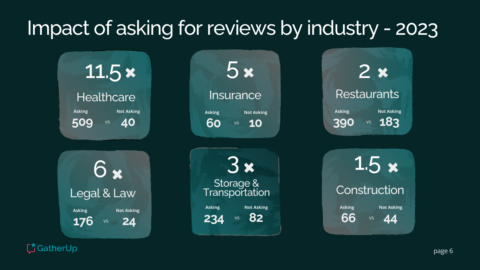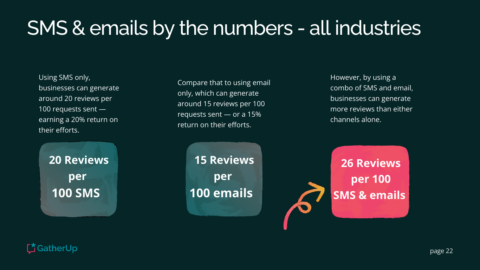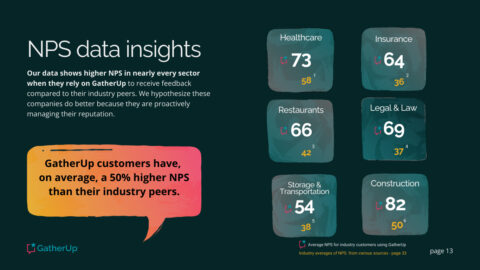Want to get rid of that sinking feeling of looking with envy at the high review volumes and star ratings of your top local competitors?
You already know that both review count and ratings are contributing to these brands’ dominance in Google’s Packs and Maps.
Today, I’ll share some good news that could help the local businesses you market catch up and compete.
A major report just published from GatherUp has studied 23,000 locations, and from this, I have three key actionable highlights for you.
My favorite overall takeaway from this interesting study is that improving your review volume, Net Promoter Score (NPS), and ratings may involve a slight adjustment in how your local business thinks about reputation management.
The data indicates that this powerful user-generated content (UGC) in the form of reviews actually belongs in the customer service/customer experience department of your operations.
Read on to see why.
Review Volume As A Customer Service KPI
In the real world, your local business has to invest maximum resources into providing the best customer service in town if you want your reputation to deliver optimum profits.
Everything you can do to provide convenient, memorable, neighborly customer experiences will impact both the offline word-of-mouth recommendations and online reviews you receive.
GatherUp’s new report takes this work ethic a step further, surfacing a striking correlation between your customers’ convenience and your review acquisition success.
Consider the following data:
1. Customers Appreciate Being Invited To Review Your Local Business
 Image from GatherUp, September 2024
Image from GatherUp, September 2024Key Takeaway: businesses that actively ask customers for reviews have, on average, 122 reviews per location versus just 53 for locations where review requests are absent.
Across multiple industries, the impact of inviting customers to share their sentiments is powerful.
According to the study, 30% of all customers will act on a well-crafted review request.
Just as you greet every person who visits your premises or phones you, it’s time to extend your customer service policy to welcome all patrons to review you.
In this context, your review volume can be seen as a key performance indicator (KPI) of whether your efforts to engage your community are succeeding or need refinement to yield a better rate of response per request.
2. Customers Respond To Your Care For Their Convenience
 Image from GatherUp, September 2024
Image from GatherUp, September 2024Key Takeaway: Only 6% of surveyed businesses use the magic combination of both SMS + email to request reviews.
A massive opportunity to increase review volume is being left on the table when your customer service policy overlooks the nicety of requesting reviews via customers’ preferred methodologies.
While email remains an excellent choice for communicating more detailed review requests to a wider audience, 48% of customers now prefer text-based review invitations. Texts have the added bonus of open rates as high as 98%.
On average, an email-only methodology delivers 15 reviews per 100 requests, SMS-only delivers 20 reviews per 100 requests, but a combined approach delivers 26 reviews per 100 requests.
These numbers quickly add up, and detailed findings by industry are available in the report.
Just as many local businesses offer indoor versus outdoor dining or in-store shopping versus delivery, you can improve customer experience, convenience, and responsiveness by diversifying your acquisition platforms.
3. Actively Engaged Customers Can Have A Higher Opinion Of Your Local Brand
 Image from GatherUp, September 2024
Image from GatherUp, September 2024Key Takeaway: Businesses that invest in reputation management software have, on average, a 50% higher NPS than industry peers.
Your NPS is a calculation of how likely it is that existing customers will recommend your local business to others.
Likewise, four of the six industries surveyed experienced a higher average star rating simply because they took the time to engage customers with a review request.
Your overall average Google star rating is widely believed to be a local search ranking factor, and any gains you can make in this regard should positively impact your visibility in Google’s Local Packs, local finders, and Maps.
Merchants have known since the dawn of commerce how engaging a customer underpins sales. In this scenario, the goal of your outreach is earning sentiment rather than transactions, but the principle remains the same.
If your customer service policy is based on ensuring that customers feel recognized, valued, and respected, you have only to extend this mindset to review requests to pursue referrals and review star growth.
Customer Service As The Nexus Of Local Business Success
I recently did an informal study of how the public rushed to the defense of the Ace Hardware franchise when someone criticized it on X (Twitter) for allegedly having higher prices than larger competitors like Lowe’s or Home Depot.
Nearly 4,000 accounts responded, with the overall sentiment of their comments being that they choose to shop at their local Ace branch because of the exceptionally high quality of its customer service.
Every local brand has options when seeking a competitive difference-maker that will help them become a memorable and trusted resource in the community.
Some common considerations include:
- Location – like locales with high foot traffic.
- Inventory – like a larger or more unusual selection of products.
- Price – like lower prices or bulk-buying options.
- Guarantees – like a no-questions-asked returns policy.
- Deals – like annual sales or bundling offers.
- Loyalty programs – like a referral program or birthday club.
- Expertise – like the Ace hardware example of having highly knowledgeable staff.
- Gimmicks – like an ad campaign that startles or amuses the public.
- Convenience – like offering home delivery or curbside pickup.
- Mission – like having a business story that strongly resonates with the public.
Each of these elements can contribute to a brand becoming known in a particular locale, but unless such factors are paired with excellent customer service, the business will struggle to earn local loyalty and optimum profits.
For example, warehouse-style brands can have an enormous inventory, but if there isn’t enough staff to help customers navigate the aisles, they can feel lost instead of assisted.
In another example, a business may be well-staffed with experts, but if they are not friendly, customers may feel belittled instead of supported.
Meanwhile, a publicity stunt like the owner of an auto dealership parachuting from a plane may momentarily grab attention on local TV, but if the customer experience feels gimmicky when a potential buyer comes to look at cars, the chance to build a strong reputation for the brand may be lost.
Monopolies lack the motivation to focus on customer care and often force the public to put up with unpleasant experiences like long hold times, long lines, or low-quality offerings.
Most small to medium local brands don’t have monopoly status. While some of the items on my bulleted list can be features of a great small brand, it’s only when they’re paired with exceptional customer experiences that these companies begin to achieve “household name” status.
Some of the traditional hallmarks of good customer service include:
- Friendliness – the staff is welcoming and possesses good communication skills.
- Adequate staffing – there are sufficient team members to prevent customers from having to wait to be helped.
- Trustworthiness – all business practices and pricing are transparent.
- Accountability – all staff are trained to resolve complaints with fairness.
- Accessibility – the business is open during stated hours and offers some form of after-hours support.
- Authoritativeness – the staff is well-versed in the offerings and policies of the business.
All of the above factors have mattered to the consumer public for centuries, but a bigger spotlight has been focused on them since the emergence of online local business reviews just a couple of decades ago.
Reviewers As The Authors Of Your Local Business Story
The quality of your customer service matters so much because it can strongly influence all of the following:
- The average star rating of your Google Business Profile.
- The individual star ratings customers leave on your Google Business Profile.
- Your ratings on other review platforms like Yelp and TripAdvisor.
- The sentiments customers share about your business in reviews across the web.
- The offline word-of-mouth (WOM) recommendations you receive.
- Your reputation in the local business community and potential B2B and cross-promotional relationships that may result from it.
Not only will each of these points impact your profitability, but your online reviews will also form a major component of both your local SEO and local search marketing strategies.
Whitespark conducts the longest-running annual local search ranking factors survey.
Review-related factors have historically ranked among the 20 greatest influences on your visibility within Google’s local search results.
The most recent survey placed all of the following factors in the top 20:
- High numerical Google ratings.
- Quantity of native Google reviews (with text).
- Sustained influx of reviews over time.
- Recency of reviews.
GatherUp’s study highlights the importance of actively asking for reviews. If you are getting customer service right at your place of business, you will get the most benefit from the ranking factors because the ratings and sentiment you receive will be largely positive.
In addition to conceptualizing ratings and reviews as major aids to your local SEO efforts, it turns out that user-generated content (UGC) is some of your most valuable local search marketing material.
A 2023 survey from Ipsos finds that consumers trust reviews from sites like Yelp more than they trust information published by brands.
In this context, it is the reviews that end up authoring the most influential narrative for your local business. Searchers trust online peers to tell them:
- What a great experience feels like at your place of business.
- How your business solves problems for customers when things go wrong.
- What the best aspects are of your business.
- Where your business needs to improve.
As SEM has matured, storytelling has emerged as a key differentiator between brands that harness its power and those who overlook it.
In the local business sector, requesting reviews is both the best and easiest way to turn customers into influential storytellers who are eager to contribute to the success of your business with their voluntary sentiments.
It can help to think of star ratings as a shorthand title for each customer review.
It’s a symbology that immediately signals a volume of information to the viewer, and in Google’s system, much of your UGC may consist only of ratings.
When you can inspire full reviews, however, a much more intriguing and interesting narrative will be at the disposal of every potential customer considering your business.
This dynamic brings us full circle back to the centrality of customer service.
I’ve been reading local business reviews for fun (and as part of my work) since their online debut, and have noticed a consistent phenomenon: Brands that go the extra mile to delight patrons get praised for it in review content.
It might be that part of your customer service policy includes offering random acts of kindness.
Your staff might be empowered to give away little perks like free desserts, really good coupons, or passes to an event.
You might have a pet watering station on your premises, dog treats at your counter, or free collar charms for the holidays.
Details like these regularly get mentioned in reviews, and are great storytelling for your local brand.
Summing Up
GatherUp’s formal report includes a wealth of industry-specific data and practical tips for pleasing potential reviewers.
The overall lesson I’ve learned from absorbing these valuable statistics should come as good tidings to local business owners in competitive markets: Your hard-earned skills at delivering exceptional customer service could be doing more to contribute to your brand’s success.
Demonstrating genuine care for the convenience and opinions of your patrons creates customer experiences that can dramatically impact reputation-oriented KPIs.
A separate large-scale review survey (which I conducted a few years ago at Moz) reached the same conclusion as the survey run by Ipsos: The public trusts what the public says about businesses more than what any business can say about itself.
Online local business reviews have become an incredibly influential sales force, and their value is an added reason to treat every customer with graciousness.
The concern you demonstrate for patrons’ preferences while asking for feedback can result in you achieving a competitive review volume, average star rating, and NPS.
It may require an expansion of your definition of customer service and some strategic planning to improve your review request processes, but your reputation is certainly worth the investment!
Read the full report from GatherUp: Maximizing Your Online Reputation.
More resources:
Featured Image: RoBird/Shutterstock
